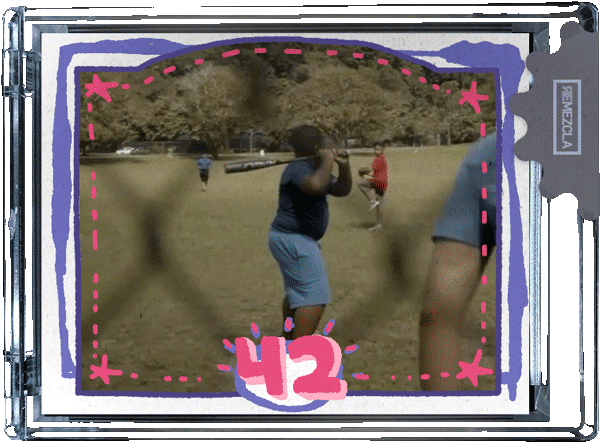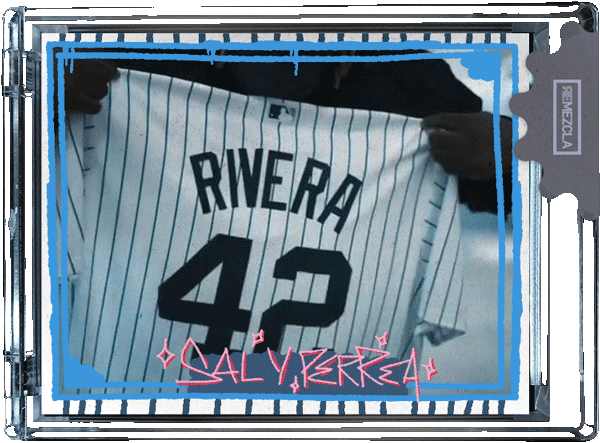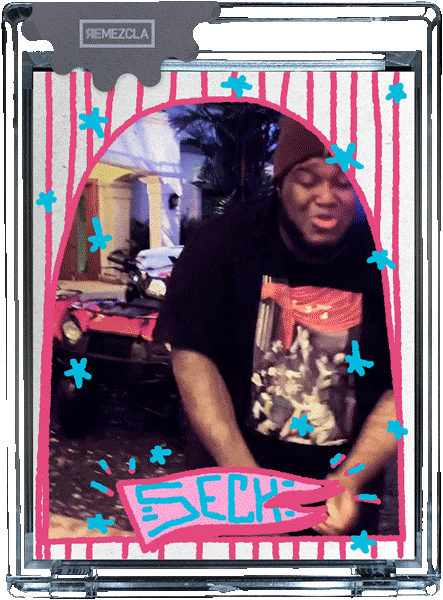Remember passionately singing Rakim Y Ken-Y’s “Down” as a teenager like you understood the love-stricken angst in its lyrics? Sech does, too. To think that the Panamanian artist will be that voice and sound for the young reggatón-loving generation of today is a delight. While his debut in 2019, Sueños, tells his story, his latest project, 42, formally defines his sound—all while carrying hefty, contagious Major League energy.
“I love that sound, and I thought to myself ‘why does romantic reggaetón not sound as aggressive anymore’? The 27-year-old says, recalling the Puerto Rican duo’s 2006 banger; Sech is on a mission to change that. The artist checks in from a baseball field in Panama with a smile that beams harder than the tropical Caribbean sun. You can tell he’s especially proud of this new project.
On 42, Sech recognizes one of his favorite icons on his personal path to become one himself. Last year, he met Mariano Rivera and got permission to use the Yankee closer’s jersey number (also Jackie Robinson’s, NBD) on the album. He, of course, had his fan girl moment and simply recalls their New York meeting as “super cool.” Sech chose the number for other reasons, too. The number 42, he shares, also means progress and stability—it’s an angel number sent to folks who should continue on the path they’re on, because their plans are good and bring success and joy. “It’s for me,” Sech asserts in Spanish. “Just the other day I was thinking about how I basically wasn’t supposed to be here. When my mom was pregnant, she thought it was a tumor or something of that nature because she was operated to not have any more kids… and even still, I was born,” he shares. “So, it’s like ‘you’re here for a reason, with a plan and/or serious purpose.”


While his debut, Sueños, was explicitly personal and direct in its narrative as he touches on his upbringing and career path, 42 is more layered in its vision, but really, simply a non-stop thread of emotion-filled club bops at the end of the day. The title is an ode to his homeland and one of its greatest stars, its essence is both a smile and middle finger to his (and your) exes, and the sonic backbone straddles the line between silky smooth Panamanian dancehall and the classic reggaetón of the early aughts to land on something timeless—a home run for the artist and the isthmus that bred him and the genre.

It’s a home run for the artist and the isthmus that bred him and the genre.
Sech has been sitting on this concept for a minute and working hard at it for some time now—since 2020, to be specific. Its title makes all the more sense with that context, too. Initially set to release at the end of 2020, it was meant to be the “closer” of that god-forsaken year. Released months later, the LP feels like the perfect collection to tide us over, and prepare us for a post-pandemic world.
The album’s precursor and immediate standout, “911,” provides the sort of top-down breakup track that seems to only be achieved by six-artist-deep tracks like the 2018’s ever-popular remix of “Te Boté”—except he does it with no one else in sight. That was an intentional point Sech sought to loudly and confidently whisper here: “My goal was to supersede everything I’d done in music prior to this moment but also, there were a lot of comments in the hallways about me not being able to stick on my own,” he says. “It’s like ‘please, kids, calm down. You know I can do it.’”
We gave the best of ourselves to represent Panama.
The last two years have brought Sech a slew of strong collaborations with everyone from Bad Bunny to Daddy Yankee; he’s grateful for each and every one of them, but was ready to prove he could hold his own—and he did. Solo tracks like “Mi Ex” and “Sal Y Perrea” outshine the rest and are perfect additions to your heartbreak recovery playlist—the first can be plopped right between “Tusa” and “Hecha Pa’ Mi” while the latter reminds us he was a DJ first.

Sech worked with his go-to, mostly Panamanian crew on this with Dimelo Flow, Cerebro and Jhon El Divertido co-producing, his brother Moises Morales handling art direction and photographers and videographers like Vomba and Squid respectively bringing the concept to life visually.
“We gave the best of ourselves to represent Panama here,” Morales tells Remezcla. We spoke to the team about how 42 came together.
PRODUCTION

Sech was very hands-on with this one, and his team thinks the project is all the better because of it. “I think that was the difference with this one,” longtime collaborator and artist in his own right Dimelo Flow says. Jhon El Divertido agrees: “I can see Sech’s musical maturity [here]… I feel like he’s different than the [Sech] he was before—as a producer, writer, artist and more importantly, as a person.”
They worked on this project for almost a year and a half, Cerebro shares—essentially all of the pandemic. The first six months of it were collectively spent in Panama, and then they were all off to Los Angeles, California as soon as it was safe. From there, New York, Miami and La Romana, Puerto Rico were a few other pit stops.
“My favorite memory was at a studio in Miami. We had just finished 42 and Sech was showing it to Justin [Quiles]” El Divertido writes, in Spanish. “Once he was done listening, Justin said ‘Diablo, Sech… You have an album full of [hit] singles.’ Listening to that filled me with a lot of beautiful feelings; I felt like it was all worth it.”
VISUALS
In the self-released documentary, directed by his brother Moises, Sech explains his love for baseball and the impact Mariano Rivera’s story had on his life as a young boy. He reiterates the sentiment to me some time later. It all began with Jackie Robinson, really. At a young age, Sech saw a film that documented the star’s story as the first Black, African American player in Major League Baseball (MLB), and the story stuck with him. Decades later, the number 42 would go to Mariano Rivera prior to being retired for all teams.
“In my mind it was like ‘of the three million people [in Panama] at the time, there was one who was crushing it on a global level,” he says. “If he can do it, why can’t I?”

“Sech has a style that’s very much his,” Vomba writes. “His music is dominated by a Panamanian dancehall that can be danced to in any part of the world. We wanted to have a universal aesthetic, too,” he says. The first video from the project was released in tandem with the album on April 15. Squid, one of the visionaries behind them, describes their creative process as “collaborative.”
This album… is proof that [Sech] will be in the Hall of Fame of reggaetón.
“I’ve done a few videos with Sech and we have a great creative understanding of what we want together. He usually sends me a few ideas to play with and I trying and give him something interesting and different.” With a sultry ode to the spaces in which these tracks are sure to shine this summer and the number 42 cleanly sprinkled in randomly throughout for viewers to point out, it’s safe to say that’s the case here. Vomba agrees, noting how much Sech values creative freedom, for himself and those around him.
“This genre is growing dominating across the globe, and I know Sech is one of those artists who is representing,” Vomba says. “Music is a form of expression and this album… is proof that [Sech] will be in the Hall of Fame of reggaetón.”




